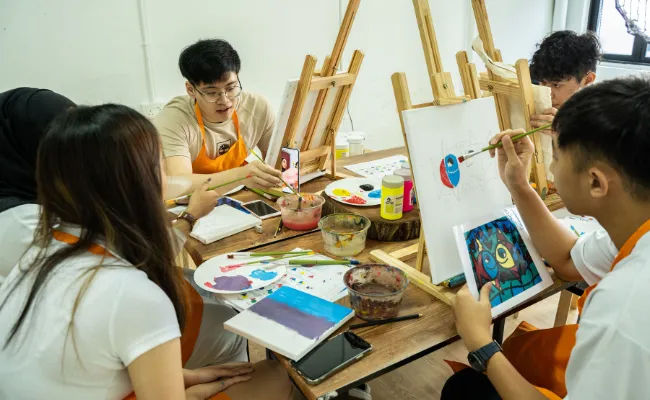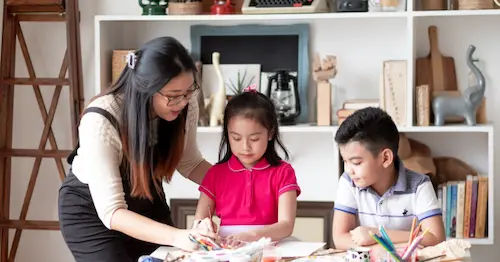Painting Techniques Singapore

Welcome to the Guide to Different Painting Techniques in Singapore! Singapore is a vibrant hub of artistic expression, and understanding various painting techniques can greatly enhance your artistic journey.
Whether you’re an aspiring artist, into Art Jamming, or simply curious about the world of painting, this guide will introduce you to the rich diversity of techniques practiced in Singapore’s art scene.
Understanding Painting Techniques
Painting techniques encompass a wide range of methods used to apply paint onto a surface, resulting in different textures, effects, and emotions. These techniques serve as tools for artists to convey their artistic vision and bring their creations to life. From delicate watercolor washes to bold impasto strokes and intricate oil glazes, each technique has its own unique characteristics and potential for creative expression.
Popular Painting Techniques in Singapore

In Singapore’s vibrant art scene, several painting techniques have gained popularity among artists. Let’s explore some of the prominent techniques in each medium:
1. Watercolor Techniques
- Wet-on-Wet Technique: This technique involves applying wet paint onto a wet surface, allowing colors to blend seamlessly and creating soft transitions.
- Dry Brush Technique: By using a dry brush with minimal water and pigment, artists can achieve textured effects, crisp lines, and intricate details.
- Wash Technique: A wash is a translucent layer of diluted paint applied over a larger area, allowing the underlying layers to show through while creating subtle color gradients.
2. Acrylic Painting Techniques
- Impasto Technique: With thick applications of paint, artists can create a textured and three-dimensional effect, adding depth and tactile quality to their artworks.
- Glazing Technique: By layering translucent washes of color over a dry base layer, artists can achieve luminosity, depth, and rich color variations in their acrylic paintings.
- Sgraffito Technique: This acrylic painting technique involves scratching or scraping into the wet or dry paint layers to reveal underlying colors or create intricate textures and details.
3. Oil Painting Techniques
- Alla Prima Technique: Also known as “wet-on-wet,” this technique involves applying wet layers of paint onto previous layers, allowing artists to work quickly and spontaneously to capture the essence and immediacy of their subjects.
- Grisaille Technique: Artists start with a monochromatic underpainting, usually in shades of gray, to establish values and create a sense of depth before adding layers of color on top.
- Scumbling Technique: Using thin, translucent layers of paint, artists apply broken brushstrokes or glazes to create atmospheric effects, soft transitions, and a sense of depth and light.
These techniques represent just a glimpse of the vast possibilities within each medium. Artists in Singapore often experiment, combine, and develop their own variations of these techniques to create unique and expressive artworks that reflect their individual style and vision.
Remember, the beauty of painting lies in exploration and personal expression. Feel free to try different techniques, adapt them to suit your artistic goals, and develop your own distinct style as you embark on your painting journey in Singapore.
Step-by-Step Guide: Trying Out Painting Techniques

1. Watercolor Technique
- Gather watercolor paints, brushes, and watercolor paper.
- Wet the paper with a clean brush and apply watercolor washes.
- Experiment with layering colors, lifting paint, and creating soft transitions.
- Try techniques such as wet-on-wet, dry brush, and wash to achieve different effects.
2. Acrylic Painting Technique
- Prepare acrylic paints, brushes, and canvas.
- Explore the impasto technique by applying thick, textured strokes using a palette knife or bristle brush.
- Play with light and shadow to create a three-dimensional effect.
- Experiment with the glazing technique by layering translucent washes of color, allowing the underlying layers to shine through.
3. Oil Painting Technique
- Get oil paints, brushes, and canvas ready.
- Begin with the alla prima technique by working quickly and applying wet layers of paint in a direct manner.
- Experiment with brushwork, blending, and capturing the essence of your subject.
- Try the grisaille technique, starting with a monochromatic underpainting to establish values, then adding layers of color to bring your artwork to life.
Singaporean Artists and their Signature Techniques
1. Jane Lee – Innovative Acrylic Manipulation
.webp/tr:w-500)
Jane Lee is a highly regarded Singaporean artist known for her innovative approach to acrylic painting. Her artworks often push the boundaries of traditional techniques as she manipulates the texture and form of the acrylic medium. Lee’s abstract works showcase a mastery of various techniques, including pouring, layering, and scraping.
By experimenting with these methods, she creates visually engaging compositions that captivate viewers with their dynamic and textured surfaces. Lee’s ability to bring out the expressive qualities of acrylic paint has made her an influential figure in the local art scene.
2. Lim Tze Peng – Ink and Wash
.webp/tr:w-500)
Lim Tze Peng, a celebrated Singaporean artist, has made a significant impact with his ink and wash paintings. Combining traditional Chinese ink painting techniques with a modern approach, Lim’s works beautifully capture Singapore’s urban landscapes and cultural heritage.
His signature technique involves using expressive brushstrokes and a monochromatic palette to convey the essence and spirit of his subjects. Lim’s artistry shines through in his ability to harmoniously blend traditional ink wash methods with contemporary brushwork, resulting in evocative and visually striking compositions.
3. Cheong Soo Pieng – Modern Figurative
.webp/tr:w-500)
Cheong Soo Pieng was a renowned Singaporean artist whose works encompassed modern figurative paintings. Known for his innovative style, Cheong blended traditional Chinese ink painting techniques with Western artistic elements. His signature technique was characterized by bold brushwork, vibrant colors, and simplified forms that effectively portrayed figures, landscapes, and still life subjects.
Cheong’s ability to infuse his artworks with a sense of dynamism and harmony, coupled with his unique approach to composition and perspective, made him a highly influential figure in shaping the modern art landscape of Singapore.
These artists represent a small sample of the exceptional talent within Singapore’s art scene. Their signature techniques showcase the diverse range of artistic expressions found in the country, inspiring both local and international art enthusiasts. Exploring the works of these Singaporean artists provides a glimpse into their unique approaches and their significant contributions to the world of art.
Painting Techniques Singapore
Painting is a great way to express your creativity and explore different artistic techniques. Singapore’s art scene is full of talented artists who have developed their own unique approaches that reflect the country’s culture, heritage, and beauty. Whether you’re looking for inspiration or just want to try something new, take some time to discover the works of these incredible local painters and learn from their signature painting techniques in Singapore.
With practice and patience, you too can create beautiful artwork with watercolor paints, acrylics, oils or inks! So don’t be afraid to pick up a brush and start experimenting – there are endless possibilities when it comes to exploring painting techniques in Singapore!
Looking for more articles? Check out our recommendations below:
- Painting Benefits in Singapore (2025)
- Best Painting Workshops in Singapore (2025)
- Benefits of Art Jamming in Singapore (2025)
- Ultimate Art Jamming Singapore Guide (2025)
- Best Art Jamming Singapore Workshops (2025)
Frequently Asked Questions (FAQ)
If you have any questions about painting techniques in Singapore, you can refer to the frequently asked questions (FAQ) about the best Painting Techniques In Singapore below:
What are the best painting techniques for beginners?
For beginners, watercolor and acrylic painting techniques are often recommended as they are relatively easier to work with, versatile, and offer a range of creative possibilities.
How can I choose the right painting technique for my style?
Experimenting with different techniques is the best way to discover the one that resonates with your artistic style. Try various techniques, attend workshops, and explore different mediums to find the technique that aligns with your vision.
Are there any specific supplies required for each technique?
Yes, each painting technique may require specific supplies. For example, watercolor techniques require watercolor paints, brushes, and watercolor paper, while acrylic techniques require acrylic paints, brushes, and canvas. It’s important to have the appropriate materials for the technique you wish to explore.
Can I combine different painting techniques in a single artwork?
Absolutely! Combining different painting techniques can add depth, texture, and visual interest to your artwork. Experimenting with the fusion of techniques allows you to create unique and captivating pieces.
How long does it take to master a painting technique?
The time required to master a painting technique varies for each individual. It depends on factors such as dedication, practice, and previous experience. Regular practice and continuous learning will contribute to improving your skills in a particular technique.
Are there any online resources or tutorials available for learning painting techniques?
Yes, there are numerous online resources, tutorials, and video demonstrations available on platforms like YouTube, art websites, and online art communities. These resources can provide step-by-step guidance, tips, and inspiration for learning and refining painting techniques.
Can I use unconventional tools for painting techniques?
Absolutely! Many artists explore unconventional tools to create unique effects and textures in their artworks. From household items to natural materials, feel free to experiment and discover new ways to express your creativity.
How can I overcome challenges or mistakes when working with painting techniques?
Challenges and mistakes are a part of the artistic process. Embrace them as opportunities for growth and learning. Practice patience, seek feedback, and keep experimenting. With time and experience, you’ll develop strategies to overcome challenges and refine your techniques.
Are there any local art communities or groups where I can learn and share painting techniques?
Yes, Singapore has a vibrant art community with various art societies, workshops, and art groups where you can connect with fellow artists, attend classes, and participate in art events. Joining these communities can provide valuable learning opportunities and a supportive network.
